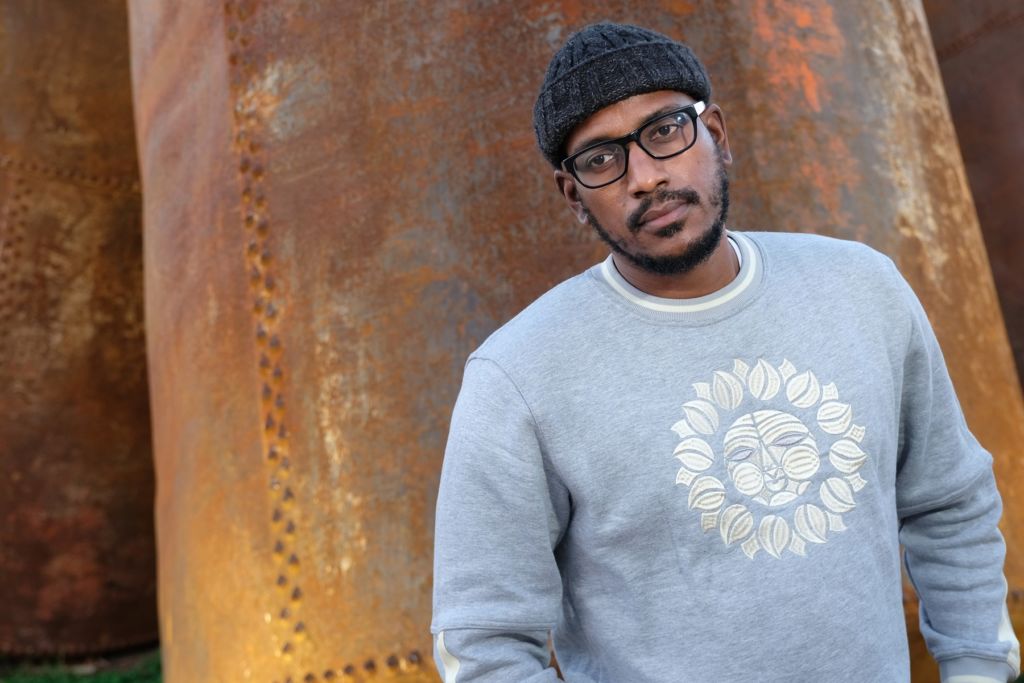'If you Don't Grow, You Die': ASC Fellowship Leads to Artistic Growth for Photographer Alvin Jacobs, Jr.

By Page Leggett
If not for an ASC Creative Renewal Fellowship, Alvin Jacobs, Jr. isn’t sure where he’d be now. It could’ve been Colorado, North Dakota or Wyoming.
He was ready to go overlanding. (More on that in a bit.) But receiving an ASC fellowship changed his plans … and his photography practice.
Not that anything needed changing. Jacobs is a successful sports and entertainment photographer. He specializes in social documentary (calling himself an “image activist”) and professional sports, portrait, editorial and fashion photography. He’s been commissioned by the NFL, NBA, and NASCAR and has been interviewed by CNN, HLN and Fox News. He’s shot for the Carolina Panthers and Jay Z’s 4:44 concert tour.
The Rockford, Illinois native’s work has more than commercial appeal. He’s also an artist at the top of his game. He was the 2018-19 Harvey B. Gantt Center artist-in-residence commissioned to photograph the award-winning images in the Gantt Center’s exhibition, “Welcome to Brookhill.”
Going old school
But Jacobs was ready to learn new tricks. And by that, we mean old tricks. The digital photographer wanted to learn to shoot and develop film.
“My plan for creative renewal is to master new photographic methods and disciplines,” he wrote in his application. “I’ve purchased analog photography equipment and will explore alternative photographic processes while hand-crafting film images.”
“Building a small studio in the lower level of my home will allow for the time and space to bring the personal touch through photo manipulation,” he continued. The equipment is expensive and takes up space; you need money to acquire it and room to store it.
Why learn the old methods when he was making a living and earning accolades with newer techniques?
“Because if you don’t grow, you die,” he said. “I started in digital. But if I don’t understand the basics, how can I grow?”
Sometimes, you have to step back to move forward.
“I actually went backwards,” Jacobs said. “I wanted to figure out: Where does this passion come from? I bought all the equipment, all the chemicals and now I understand how to fully develop analog. I didn’t understand that before.
“Now, there’s more I can do,” said the self-taught analog photographer. “There are dozens of techniques that people who only know digital aren’t aware of. So, now I have the ability to introduce old practices to a new audience.”
He appreciates aspects of both methods. “I like the speed of digital, but I like the art form and the process of analog,” he said.
He’s even come to learn that there are some advantages to the old school way of shooting.
“With analog, you’re a part of the process from the beginning to the end,” he said. “And you don’t know what you’re going to come up with. So, you have to be very meticulous with your settings. It makes you pay more attention.”
And not surprisingly, the old methods he’s learned have impacted his digital practice.
“I have become more intentional,” he said. “There’s the one opportunity I have to do what I need to do, and it better be correct. I never was a ‘spray and play’ photographer to begin with. I’ve always been intentional. Analog has taught me to slow down because, with only 36 exposures before you have to change your film out, you don’t have all day. You’ve got to be efficient. This process put me back in touch with the truest part of the art form.”
Jacobs wanted to investigate where his art form originated – to get to the basics of why he loves it. He said he wondered: “What happens if you really, really know where it comes from?”
“I know a lot of painters who only paint using iPads, and there’s nothing wrong with that,” he continued. “But what if you can do both? What if anytime you feel like you can pull out the paint brushes and anytime you feel like it, you can use your iPad? You have a choice. You understand the entire process. To me, that was important.”
Important enough to put his big plans on hold indefinitely.
Change in plans
“My lease was ending,” he said of the time last year he decided to apply. “I was like, maybe I should go back home. Maybe I should go back to Illinois. I was really getting into outdoor lifestyle called overlanding. You get an SUV or pickup truck, and you have everything on that vehicle you need to be away from home for weeks or months at a time. I had the SUV; I had the rooftop tent. I was going to put my stuff in storage and just go travel around America and camp with my dog. I had just rescued a pit bull.
“But then the fellowship really gave me the validation that I was doing the right thing in the right place at the right time,” he said. “It gave me a sign. I was getting ready to check out, but this fellowship pulled me back into what I love.”
Jacobs encourages anyone who’s considering applying for an ASC fellowship to go for it.
“The application process is a lot,” he said. “But it’s an important exercise to go through. It’s important to be able to articulate and to convey a passion. The application process forces you to articulate why you do what you do and what your goals are. Just going through the application process can teach you a lot.”
Some of the language in Jacobs’ application was positively lyrical. On the impact he imagined the fellowship would have on him, he wrote: “The link between my current work is the medium of photography, black-and-white imagery and the ability to slow down the instant gratification process of digital camera technology.”
“Applying,” he advises fellow creatives, “could end up changing everything about what you love about the work you create.”
“I’m an artist again,” he said. “I’m literally creating beautiful works, at my own leisure, from the beginning to the end. And it’s amazing. I’m a part of the entire process.”
Follow along. Learn more about Jacobs at www.alvincjacobsjr.com. Follow him on Instagram at @acjphoto.

